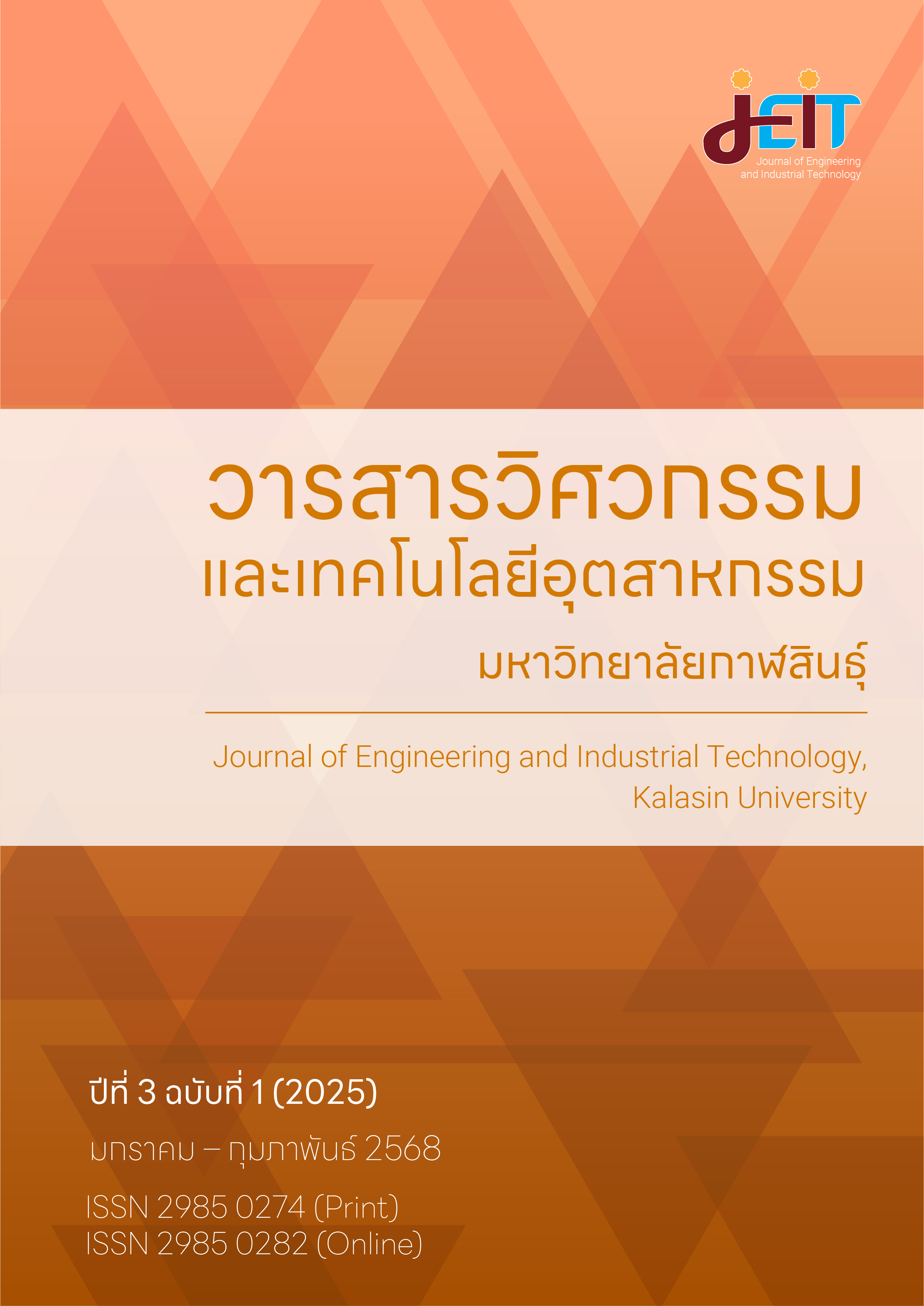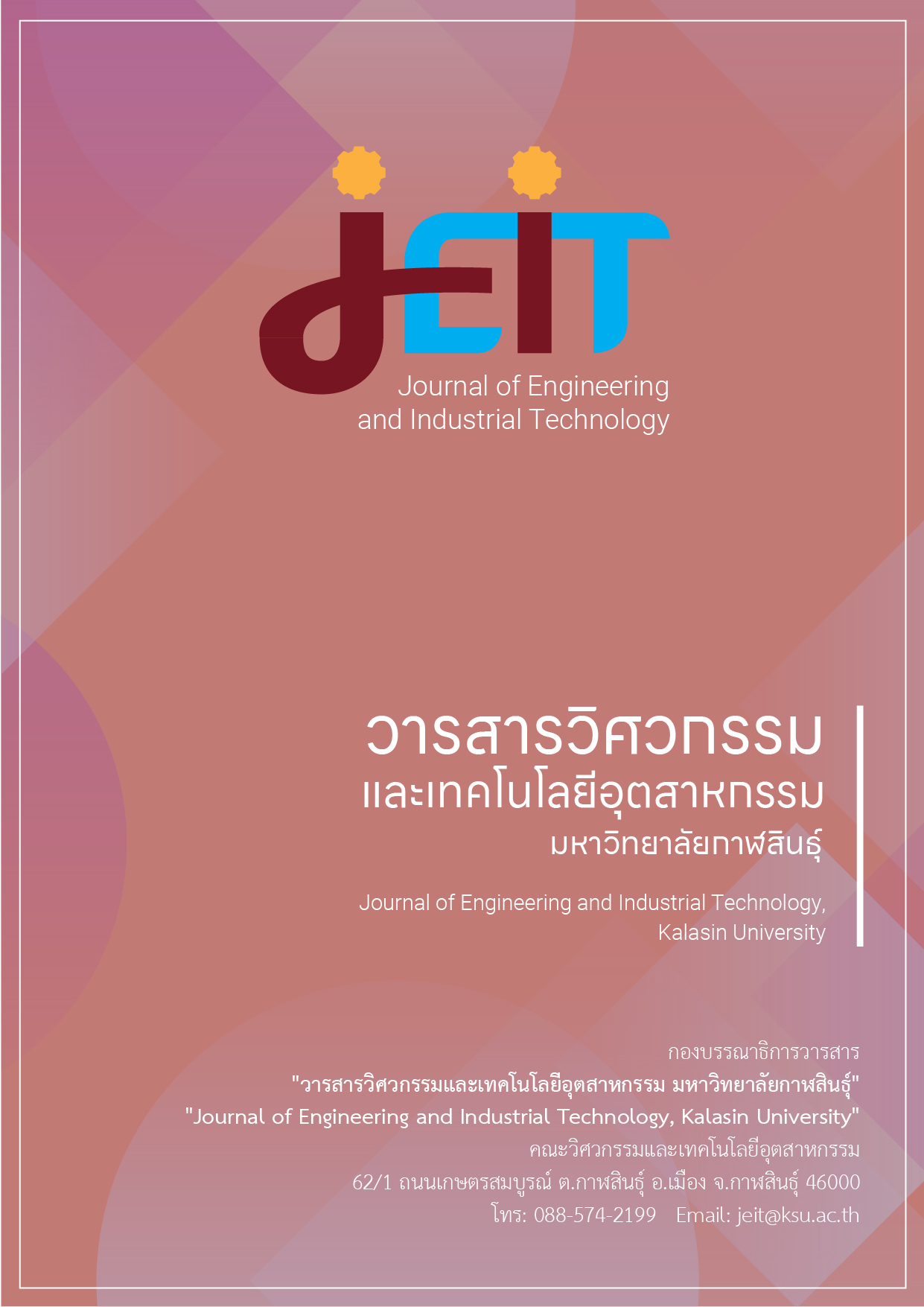The Manufacturing Improvement with ECRS: A Case Study of The J Flag Manufacturing Process
DOI:
https://doi.org/10.14456/jeit.2025.5Keywords:
Waste reduction, Productivity improvement, Production process improvementAbstract
This research aims to improve the production process of Japanese flagpoles for vinyl signboards by applying the ECRS waste reduction principle to minimize production time and distance while establishing a standardized process. The study begins with an analysis of the current production process using flow process charts and diagrams. Subsequently, data was analyzed to identify the root causes of inefficiencies through brainstorming sessions with stakeholders, utilizing a fishbone diagram. The ECRS principle is then employed to pinpoint waste factors and optimize the production process into
a standardized workflow. The research results are evaluated based on reductions in the number of operational steps, time, and distance. The findings reveal that before the improvement, the production process consisted of 39 steps, taking 12 hours, 4 minutes, and 29 seconds, with a total production distance of 176 meters. After the improvement, the number of steps was reduced to 29, the production time decreased to 8 hours, 45 minutes, and 7 seconds, and the distance was shortened to 127.5 meters. This represents a 25.64% reduction in operational steps, a 27.52% decrease in production time, and a 27.56% reduction in production distance. In conclusion, the application of the ECRS waste reduction principle effectively enhances production efficiency and improves the competitiveness of the manufacturing process.
References
[1] W. Wu, C. Yang, and X. Li, "Application of extension innovation method in assembly production process optimization," Procedia Computer Science, vol. 214, pp. 412-419, 2022.
[2] R. Selvaraj and V. R. Sathish Kumar, "Productivity improvement in oil free airend assembly," Materials Today: Proceedings, vol. 62, pp. 1065-1071, 2022.
[3] N. Suranuntchai and P. Chutima, "Practical implementation of lean management techniques and ergonomic consideration to improve manual assembly process during the COVID-19 crisis," Engineering Journal, vol. 27, no. 2, pp. 29-43, 2023.
[4] วิชญุตร์ งามสะอาด, ปิยะเนตร นาคสีดี และ ณัฐพล อีงประเสริฐ, "การปรับปรุงกระบวนการผลิตเสื้อผ้าสำเร็จรูปเพื่อเพิ่มประสิทธิภาพในการผลิต: กรณีศึกษาบริษัท ABC จำกัด," วารสารวิชาการเทคโนโลยีอุตสาหกรรม, ปีที่ 19, ฉบับที่ 3, หน้า 160-176, ก.ย.–ธ.ค. 2566.
[5] ชลาลัย วงเวียน, อลงกรณ์ ฉัตรเมืองปัก และ สุภารัตน์ ค้างสันเทียะ, "การปรับปรุงประสิทธิภาพในกระบวนการผลิตเสื้อผ้าสำเร็จรูป กรณีศึกษา โรงงานผลิตเสื้อผ้าสำเร็จรูปแห่งหนึ่ง," วารสารวิชาการวิทยสารบูรณาการเทคโนโลยีอุตสาหกรรมและวิศวกรรมประยุกต์, ปีที่ 17, ฉบับที่ 1, หน้า 1-14, ม.ค.–มิ.ย. 2567.
[6] J. Ruanggoon, P. Pornpayuhakeit, and P. Opasvitayarux, "Application of lean concepts to improve consumable disbursement process to reduce waiting time in a public hospital in Bangkok," RMUTSB Academic Journal, vol. 8, no. 2, pp. 192-205, 2023.
[7] R. M. Bârsan and F. M. Codrea, "Lean university: Applying the ECRS method to improve an administrative process," MATEC Web of Conferences, vol. 290, pp. 1-6, 2019.
[8] P. Ketchanchai, K. Tangchaidee, and N. Kongprasert, "Lean warehouse management through value stream mapping: A case study of sugar manufacturing company in Thailand," in IEEE 8th International Conference on Industrial Engineering and Applications, Kyoto, Japan, 2021, pp. 192-196.
[9] B. Suhardi, N. Anisa, P. W. Laksono, and P. Lou, "Minimizing waste using lean manufacturing and ECRS principle in Indonesian furniture industry," Cogent Engineering, vol. 6, no. 1, 2019.
[10] R. Saravanan, M. S. Srinivasa Rao, N. Sunkara, and T. Malyadri, "Six sigma’s ECRS technique to down cost and time of manufacturing – An experimental investigation," AIP Conference Proceedings, vol. 2283, no. 1, 2020.
[11] C. Kasemset, C. Boonmee, and P. Khuntaporn, "Application of MFCA and ECRS in waste reduction: A case study of electronic parts factory," in Proceedings of the 2016 International Conference on Industrial Engineering and Operations Management, Kuala Lumpur, Malaysia, 2016, pp. 1844-1853.
[12] W. Wattanutchariya and A. Ounjai, "Efficiency improvement of dried longan production line using ECRS principles," in The 7th International Conference on Logistics and Transport, Lyon, France, 2015.
[13] H. Kelendar and M. A. Mohammed, "Lean and the ECRS principle: Developing a framework to minimise waste in healthcare sectors," International Journal of Public Health and Clinical Sciences, vol. 7, no. 3, pp. 98-110, 2020.
[14] P. Gao and J. Q. Wen, "Process optimization for wiring technology of aircraft harness based on ECRS principle," in 21st International Conference on Industrial Engineering and Engineering Management 2014, Atlantis Press, Paris, 2015, pp. 349-353.
[15] A. K. Nisa, M. Hisjam, and S. A. Helmi, "Improvement of work method with eliminate, combine, rearrange, and simplify (ECRS) concept in a manufacturing company: A case study," Materials Science and Engineering, vol. 1096, pp. 1-10, 2020.
[16] A. F. O. Pertiwi and R. D. Astuti, "Increased line efficiency by improved work methods with the ECRS concept in a washing machine production: A case study," Jurnal Sistem dan Manajemen Industri, vol. 4, no. 1, pp. 13-29, 2020.
[17] พรศิริ คำหล้า และคณะ, "การศึกษาเวลามาตรฐานในกระบวนการผลิตคอนกรีตผสมเสร็จด้วยการจับเวลาโดยตรง," วารสารวิชาการเทคโนโลยีอุตสาหกรรม, ปีที่ 6, ฉบับที่ 2, หน้า 41-51, ก.ค.–ธ.ค. 2564.
Downloads
Published
How to Cite
Issue
Section
Categories
License
Copyright (c) 2025 Journal of Engineering and Industrial Technology, Kalasin University

This work is licensed under a Creative Commons Attribution-NonCommercial-NoDerivatives 4.0 International License.
ลิขสิทธิ์ของวารสาร
เนื้อหาและข้อมูลในบทความที่ลงตีพิมพ์ในวารสารศูนย์ดัชนีการอ้างอิงวารสารไทย ถือเป็นข้อคิดเห็นและความรับผิดชอบของผู้เขียนบทความโดยตรงซึ่งกองบรรณาธิการวารสาร ไม่จำเป็นต้องเห็นด้วย หรือร่วมรับผิดชอบใด ๆ
บทความ ข้อมูล เนื้อหา รูปภาพ ฯลฯ ที่ได้รับการตีพิมพ์ในวารสารศูนย์ดัชนีการอ้างอิงวารสารไทย ถือเป็นลิขสิทธิ์ของวารสารศูนย์ดัชนีการอ้างอิงวารสารไทย หากบุคคลหรือหน่วยงานใดต้องการนำทั้งหมดหรือส่วนหนึ่งส่วนใดไปเผยแพร่ต่อหรือเพื่อกระทำการใด จะต้องได้รับอนุญาตเป็นลายลักอักษรจากวารสารศูนย์ดัชนีการอ้างอิงวารสารไทยก่อนเท่านั้น


